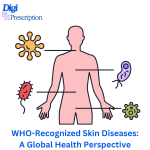
Skin diseases are a major global health concern, impacting millions of people each year. The World Health Organization (WHO) recognizes a wide range of skin conditions that can affect both the quality of life and overall health of individuals. Some skin diseases are common and often manageable, while others are more severe and can have life-altering consequences. This blog post explores WHO-recognized skin diseases and their global impact.
1. Acne Vulgaris
Acne is one of the most prevalent skin conditions globally, particularly among adolescents and young adults. The WHO lists acne as a leading dermatological disorder, with approximately 9.4% of the global population affected.
2. Eczema (Atopic Dermatitis)
Eczema, or atopic dermatitis, is a chronic inflammatory condition that causes itchy, inflamed skin. It is common among children but can persist into adulthood. The condition is often linked to allergies, asthma, and a family history of such diseases. WHO recognizes eczema as a significant health concern, particularly in developed countries, where its prevalence has increased in recent years.
3. Psoriasis
Psoriasis is a chronic autoimmune disease that accelerates the production of skin cells, causing thick, scaly patches. It is one of the most common skin diseases worldwide and affects both men and women, typically manifesting in early adulthood. WHO recognizes psoriasis as a serious disease because it can lead to significant physical and psychological distress. It is also associated with other health conditions such as heart disease and diabetes.
4. Skin Cancer
Skin cancer is the most common type of cancer worldwide, and the WHO has identified it as a growing health problem due to increasing exposure to ultraviolet (UV) radiation. Skin cancer is preventable through sun protection, and early detection can significantly improve survival rates. The WHO emphasizes public health measures like education on sun safety and early screening to reduce the burden of skin cancer.
5. Leprosy
While rare, leprosy is still a significant concern in some parts of the world, particularly in countries like India, Brazil, and Indonesia. The WHO has launched initiatives to eliminate leprosy as a public health problem through early diagnosis, multi-drug therapy, and support for individuals affected by the disease.
6. Fungal Infections
Fungal skin infections, such as athlete's foot, ringworm, and candidiasis, are common worldwide. They can be caused by exposure to warm and moist environments or poor hygiene. The WHO has highlighted the importance of preventing and treating fungal infections to avoid complications, especially in vulnerable populations. These infections are often treated with antifungal medications, but resistance to treatment is becoming an increasing concern.
7. Scabies
It leads to intense itching and red, inflamed skin. Scabies is prevalent in crowded and unsanitary conditions, making it a major concern in refugee camps, prisons, and other high-density environments. WHO has identified scabies as a neglected tropical disease and recommends mass treatment campaigns in affected areas to control its spread.
8. HIV-Related Skin Conditions
People living with HIV/AIDS are more susceptible to various skin diseases due to a weakened immune system. Skin conditions such as herpes simplex, shingles, and fungal infections are common among individuals with HIV. The WHO recognizes the importance of addressing these skin issues as part of comprehensive HIV care, as skin conditions can indicate HIV progression and affect a person's quality of life.
9. Vitiligo
Vitiligo is a condition in which the skin loses pigment, leading to white patches. The cause of vitiligo is not entirely understood, but it is thought to involve an autoimmune response that attacks melanocytes, the cells responsible for producing pigment. WHO recognizes vitiligo as a condition with significant psychological impact, especially in societies where skin color plays a crucial role in social acceptance.
10. Molluscum Contagiosum
Molluscum contagiosum is a viral skin infection that causes small, raised, flesh-colored bumps with a central dimple. The disease is highly contagious and is typically spread through direct skin-to-skin contact or contaminated objects. While not serious, molluscum contagiosum can be persistent and is especially common in children and people with weakened immune systems. The WHO acknowledges this condition as a public health issue, particularly in areas with limited access to healthcare.
11. Dermatitis
Dermatitis refers to inflammation of the skin, leading to redness, swelling, and itching. It includes several conditions, such as contact dermatitis, seborrheic dermatitis, and atopic dermatitis. WHO recognizes dermatitis as a widespread concern, particularly in areas with poor access to healthcare and hygiene. Environmental factors, such as pollution and allergens, often trigger flare-ups of dermatitis.
Conclusion:
Skin diseases are a significant global health challenge, and the World Health Organization continues to work toward increasing awareness, access to treatment, and prevention strategies for various skin conditions. By understanding the common skin diseases recognized by the WHO, individuals can take steps to protect their skin and seek appropriate medical care when needed.
References:
- Mayo Clinic – Common Skin Conditions. https://www.mayoclinic.org
- Centers for Disease Control and Prevention (CDC) – Skin Infections and Conditions. https://www.cdc.gov
- American Academy of Dermatology (AAD) – Dermatology Disease Database. https://www.aad.org
